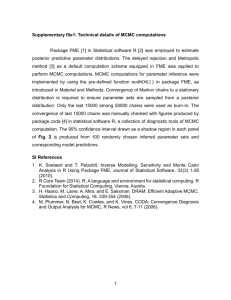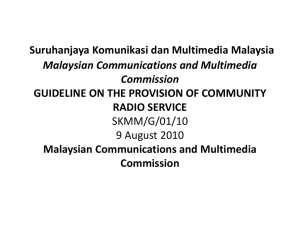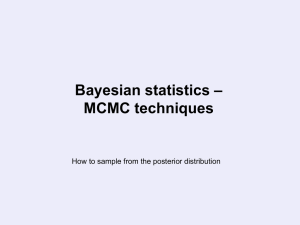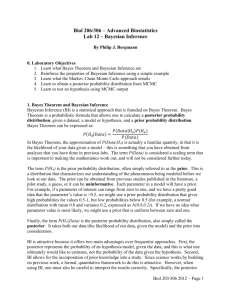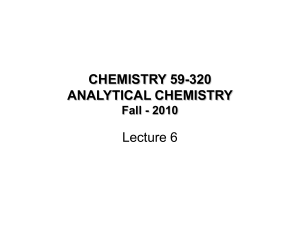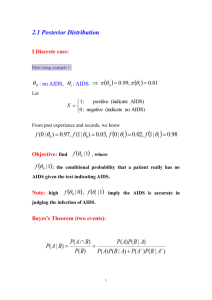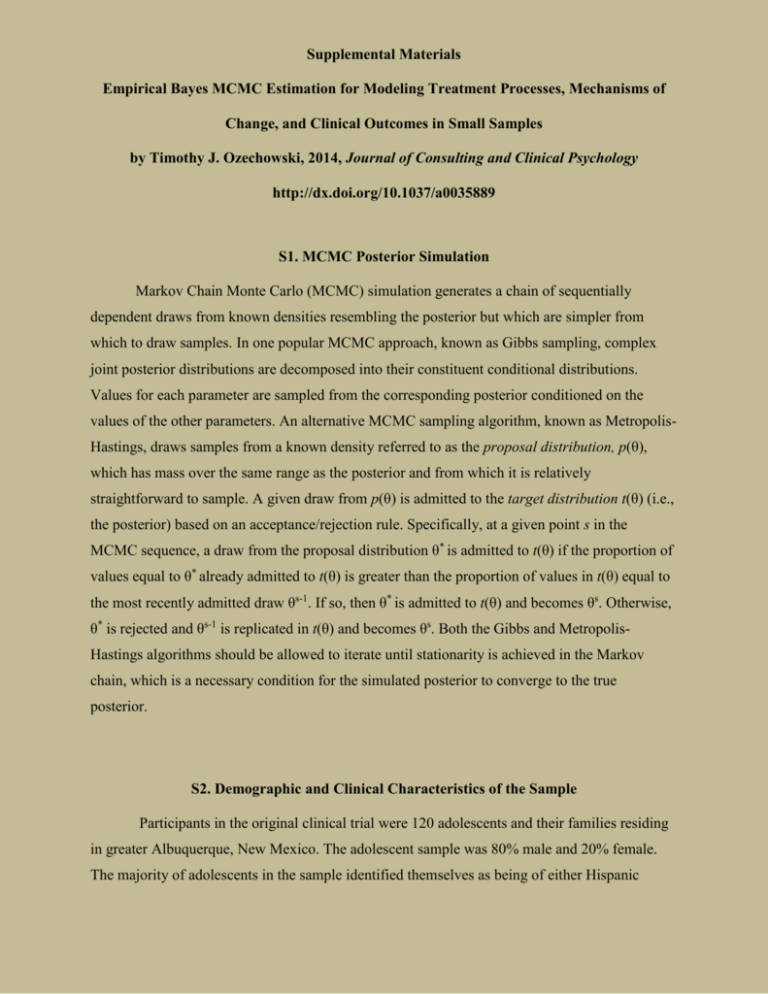
Supplemental Materials
Empirical Bayes MCMC Estimation for Modeling Treatment Processes, Mechanisms of
Change, and Clinical Outcomes in Small Samples
by Timothy J. Ozechowski, 2014, Journal of Consulting and Clinical Psychology
http://dx.doi.org/10.1037/a0035889
S1. MCMC Posterior Simulation
Markov Chain Monte Carlo (MCMC) simulation generates a chain of sequentially
dependent draws from known densities resembling the posterior but which are simpler from
which to draw samples. In one popular MCMC approach, known as Gibbs sampling, complex
joint posterior distributions are decomposed into their constituent conditional distributions.
Values for each parameter are sampled from the corresponding posterior conditioned on the
values of the other parameters. An alternative MCMC sampling algorithm, known as MetropolisHastings, draws samples from a known density referred to as the proposal distribution, p(θ),
which has mass over the same range as the posterior and from which it is relatively
straightforward to sample. A given draw from p(θ) is admitted to the target distribution t(θ) (i.e.,
the posterior) based on an acceptance/rejection rule. Specifically, at a given point s in the
MCMC sequence, a draw from the proposal distribution θ* is admitted to t(θ) if the proportion of
values equal to θ* already admitted to t(θ) is greater than the proportion of values in t(θ) equal to
the most recently admitted draw θs-1. If so, then θ* is admitted to t(θ) and becomes θs. Otherwise,
θ* is rejected and θs-1 is replicated in t(θ) and becomes θs. Both the Gibbs and MetropolisHastings algorithms should be allowed to iterate until stationarity is achieved in the Markov
chain, which is a necessary condition for the simulated posterior to converge to the true
posterior.
S2. Demographic and Clinical Characteristics of the Sample
Participants in the original clinical trial were 120 adolescents and their families residing
in greater Albuquerque, New Mexico. The adolescent sample was 80% male and 20% female.
The majority of adolescents in the sample identified themselves as being of either Hispanic
Supplemental Materials
Empirical Bayes MCMC Estimation for Modeling Treatment Processes, Mechanisms of
Change, and Clinical Outcomes in Small Samples
by Timothy J. Ozechowski, 2014, Journal of Consulting and Clinical Psychology
http://dx.doi.org/10.1037/a0035889
(46.7%) or Anglo (38.3%) ethnic origin. The remaining 15% identified as either Native
American or having a mixed ethnic background. The mean age of the adolescent sample was
15.6 years (SD = 1.0). Participants were referred to the research clinic to receive outpatient
adolescent substance abuse treatment. Adolescents meeting official diagnostic criteria for
substance abuse or dependence were eligible to participate in the study. The study focused on
illicit substance abuse. As such, adolescents whose primary substance of abuse was alcohol or
tobacco were excluded from participation.
Marijuana was the primary substance of abuse among the adolescents in the parent
clinical trial. On average, adolescents reported using marijuana on 56.8% (SD = 31.8) of the past
90 days prior to treatment intake. Use of any substance other than tobacco was reported on an
average of 60% (SD = 31.0) of the past 90 days prior to treatment intake. In addition to substance
abuse, adolescent participants exhibited substantial comorbid emotional and behavioral
problems. Specifically, 70.8% of adolescents were rated at or above the borderline clinical
threshold for delinquent behavior problems based on parent reports on the Child Behavior
Checklist (CBCL; Achenbach, 1991). Moreover, 30% of the adolescent sample scored at or
above the threshold for clinical depression on the Beck Depression Inventory (BDI; Beck &
Steer, 1987) based on adolescent-specific guidelines for the BDI specified by Roberts,
Lewinsohn, and Seeley (1991).
S3. Coder Training
All training activities were conducted by the author of this article. The initial components
of the training process focused on didactic study of the principles and practices of Functional
Family Therapy (FFT) as well as of the Functional Family Therapy Coding and Rating Scale
Supplemental Materials
Empirical Bayes MCMC Estimation for Modeling Treatment Processes, Mechanisms of
Change, and Clinical Outcomes in Small Samples
by Timothy J. Ozechowski, 2014, Journal of Consulting and Clinical Psychology
http://dx.doi.org/10.1037/a0035889
(FFT CARS) coding manual. The coders practiced using the FFT CARS to code written therapy
transcripts initially and then were trained to code digitized video files of FFT sessions.
Videotapes of FFT sessions were converted to digital MPEG files using a digital video data
acquisition and management system. Coders used a specially designed Windows-based graphical
user interface to access the MPEG files, which were stored within a relational database on a local
server. The coders viewed the digital video files on a computer workstation monitor and entered
codes in real time for each discernible therapist intervention using a numerical keypad. Time-in
and time-out codes were automatically associated with each coded entry. At the end of each
observed FFT session, the collection of video segments and associated codes was stored as an
ASCII text file that could be readily imported into any commonly used statistical software
package for analytic purposes. Each week during the training period, the coders independently
observed and coded a video-recorded FFT session from an archive of recordings designated for
training purposes. Each week, the trainer computed rates of agreement between the two coders
on each of the FFT CARS intervention and context codes. The training continued until the coders
were able to exhibit 70% agreement on all codes for four consecutive weeks. The training
process lasted approximately four months.
S4. Positive Definite Posterior Covariance Matrices and the Cholesky Factorization
In general, a matrix of numerical elements is said to be positive definite if it is square,
symmetrical, and all its eigenvalues are greater than zero (Leon, 2009). Briefly, an eigenvalue is
the variance associated with a principal component, which is a weighted combination of
observed variables capturing a unique portion of the overall variance—similar to a factor in
factor analysis (Wothke, 1993). A non-positive eigenvalue is a “red flag” signaling that the
corresponding weighted combination of variables has a zero variance, which often is attributable
Supplemental Materials
Empirical Bayes MCMC Estimation for Modeling Treatment Processes, Mechanisms of
Change, and Clinical Outcomes in Small Samples
by Timothy J. Ozechowski, 2014, Journal of Consulting and Clinical Psychology
http://dx.doi.org/10.1037/a0035889
to high degrees of collinearity or redundancy between variables. Non-positive definite
covariance matrices are problematic mathematically because they cannot be inverted due to
division by zero. In the ML estimation setting, a non-positive definite input covariance matrix,
therefore, precludes performing the matrix algebra required to optimize the likelihood function
and obtain model parameter estimates. Likewise, if the estimated or model-implied covariance
matrix in an SEM analysis is non-positive definite, it cannot be shown that the observed data are
plausible given the model (i.e., the statistical model cannot be shown to fit the data). From a
Bayesian perspective, non-positive definite posterior covariance matrices raise suspicions
regarding the validity of the model as a plausible representation of processes by which the data
were produced.
If a given SEM covariance matrix M is positive definite, then the Cholesky factorization
may be obtained such that M = L∙LT where L is the lower triangular portion of M and LT is the
transpose of L (i.e., a re-expression of L with the columns and rows reversed). If the Cholesky
factorization of M can be computed, then M is positive definite. If the Cholesky factorization of
M cannot be computed, then M is not positive definite.
In cases where the Cholseky factorization of M cannot be obtained, the source of the nonpositive definiteness may be isolated by decomposing M into smaller submatrices (e.g., all 2 2
submatrices comprising M) and implementing the Cholesky factorization on each submatrix.
Submatrices for which the Cholesky factorization fails would be indicative of parameters in the
SEM that may be misspecified. Careful respecification of such parameters would most likely
rectify the non-positive definiteness in M.
̂ Using the SAS NLMIXED Procedure
S5. Obtaining 𝑹
Supplemental Materials
Empirical Bayes MCMC Estimation for Modeling Treatment Processes, Mechanisms of
Change, and Clinical Outcomes in Small Samples
by Timothy J. Ozechowski, 2014, Journal of Consulting and Clinical Psychology
http://dx.doi.org/10.1037/a0035889
Although PROC MCMC does not compute the 𝑅̂ index, 𝑅̂ may be computed using the
NLMIXED procedure within SAS/STAT software package. First, the posterior samples from
each MCMC chain must be output to a unitary SAS data set in which all chains are “stacked”
vertically. Next, a random-intercept-only model may be fit to this stacked data set using the
NLMIXED procedure, with “chain” being the clustering, or Level 2, unit and the posterior draws
within each chain for a given parameter constituting the Level 1 observations. The NLIMXED
procedure automatically computes W and B as parameters of the random-intercept-only model.
The value of 𝑅̂ then may be computed by entering the computational formula for 𝑅̂ into the
ESTIMATE statement in NLIMXED. For a large number of parameters, the execution of this
procedure may be automated by embedding the NLMIXED code within a SAS macro program
(see Figure S3).
S6. Assessment of Model Fit Based on the Posterior Predictive Distribution
Typically, comparisons between the observed data and predicted values sampled from the
PPD are based on test statistics, or scalar summaries computed from samples of observations
(see Gelman et al., 2004, p. 162; Gelman & Meng, 1996, p. 197). For continuous normally
distributed observed variables, the most efficient summary test statistics are the sample mean and
standard deviation. The median, mode, minimum, and maximum values may be utilized as test
statistics as well. In a Bayesian assessment of model fit, a given test statistic based on the
observed sample data, T(yobs), may be compared to a set of corresponding test statistics
computed from R simulated samples or replications drawn from the PPD, T(yr), where r = 1, . . .,
R. The most straightforward way of comparing T(yobs) and T(yr) is to plot a histogram of the
T(yr) values and pinpoint the location of T(yobs) on this histogram. If the model under
Supplemental Materials
Empirical Bayes MCMC Estimation for Modeling Treatment Processes, Mechanisms of
Change, and Clinical Outcomes in Small Samples
by Timothy J. Ozechowski, 2014, Journal of Consulting and Clinical Psychology
http://dx.doi.org/10.1037/a0035889
investigation exhibits a good fit to the data from a Bayesian point of view, then the value of
T(yobs) would be expected for fall near the center of the histogram of T(yr) values, suggesting that
the observed data are highly plausible given the Bayesian posterior parameter estimates.
Alternatively, one may compute the proportion of T(yr) values that are equal to or greater than
T(yobs), that is, Pr [T(yr) ≥ T(yobs)]. This proportion, known as the posterior predictive p value
(ppp), expresses the probability that the predicted values derived from the Bayesian estimates of
the model parameters are more extreme than the observed data. For a good-fitting model ppp
would be expected to equal approximately 0.5, again indicating that T(yobs) falls in the center of
the distribution of predicted test statistics T(yr) and that the observed sample data are highly
plausible given the Bayesian estimates of the model parameters (see Muthén & Asparouhov,
2012).
A Robust Assessment of Model Fit Given a Small Sample
When sample sizes are prohibitively small, any given sample statistic T(yobs) may be
biased, which in turn may lead to distorted or incorrect assessments of model fit based on
comparisons between T(yr) and T(yobs). Therefore, rather than comparing T(yr) with a single
point estimate T(yobs) calculated from the sample data, in the current demonstration analysis,
values of T(yr) were gauged against the sampling distribution of T(yobs), which was obtained
using bootstrap resampling of the sample data (Efron & Tibshirani, 1993). Briefly, bootstrap
resampling entails randomly selecting observations with replacement from a given sample of size
n until B bootstrap samples of size n have been drawn using only the observations in the original
sample y1, …, yn. A given test statistic T(yb) may be computed for each of the B bootstrap
samples (b = 1, …, B). The collection of bootstrap test statistics simulates the sampling
distribution of T(yobs) with the expected value estimated as 𝜇̂ 𝐵 =
1
𝐵
∑𝐵𝑏=1 𝑇(𝑦 𝑏 ) and variance
Supplemental Materials
Empirical Bayes MCMC Estimation for Modeling Treatment Processes, Mechanisms of
Change, and Clinical Outcomes in Small Samples
by Timothy J. Ozechowski, 2014, Journal of Consulting and Clinical Psychology
http://dx.doi.org/10.1037/a0035889
1
estimated as 𝜎̂𝐵2 = 𝐵−1 ∙ ∑𝐵𝑏=1(𝑇(𝑦 𝑏 ) −𝜇̂ 𝐵 )2. The square root of the estimated variance of the
bootstrap sampling distribution, 𝜎̂𝐵 , is a robust estimate of the standard error of T(yobs), which
quantifies the sampling variability associated with T(yobs). With regard to Bayesian assessment
of model fit, a robust estimate of the standard error of T(yobs) permits the specification of a
(frequentist) confidence interval within which values of T(yrep) may be regarded as being
consistent with T(yobs) and beyond which values of T(yrep) are likely to be discordant with
T(yobs), that is, biased due to model misspecification or lack of fit. Comparing values of T(yrep)
against a bootstrap “minimal bias” confidence interval for T(yobs) rather than a single point
estimate robustifies the assessment of model fit against bias and imprecision inherent in T(yobs)
due to the small sample size.
To specify a confidence interval defining a region of “minimal-bias” surrounding T(yobs),
a useful convention set forth by Schafer and colleagues holds that bias in a statistical estimate
becomes appreciable when it exceeds 50% of one standard error of the estimate (Collins,
Schafer, & Cam, 2001; Schafer & Kang, 2008). Using this guideline, a confidence interval
within which values of T(yr) may be regarded as minimally biased with regard to the observed
data may be specified as
𝐼: (𝜇̂ 𝐵 – 0.5∙𝜎̂𝐵 ) ≤ T(yr) ≤ (𝜇̂ 𝐵 + 0.5∙𝜎̂𝐵 ).
(S1)
The expression in Equation S1 states that values of T(yr) between –0.5 and +0.5 estimated
standard errors from the estimated mean of the sampling distribution of T(yobs) are contained in
the minimal bias interval. Furthermore, a coverage probability 𝑃̂𝑐 for I may be estimated as the
proportion of values of T(yr) that are contained within I. A good-fitting model from a Bayesian
perspective would be expected to produce estimates of 𝑃̂𝑐 close to 1.0 for each variable in a given
statistical model, indicating that nearly all of the posterior predicted values are contained in the
Supplemental Materials
Empirical Bayes MCMC Estimation for Modeling Treatment Processes, Mechanisms of
Change, and Clinical Outcomes in Small Samples
by Timothy J. Ozechowski, 2014, Journal of Consulting and Clinical Psychology
http://dx.doi.org/10.1037/a0035889
minimal bias interval I. Values of 𝑃̂𝑐 substantially lower than 1.0 (i.e., less than 0.90) would
indicate that a sizable proportion of posterior predicted values are not contained in I, suggesting
the model does not fit the data well for a given variable.
In the current demonstration analysis, T(yobs) was chosen to be the sample mean for each
variable in the SEM analysis and T(yr) (r = 1, …, R) was a corresponding set of predicted means
based on R = 500 simulated samples from the PPD, which were generated by the PROC MCMC
program (see line 89 of the MCMC code presented in Figure S1). The decision to set R = 500
was informed by Gelman et al.’s (2004, p. 164) demonstration of the PPD for Bayesian model
checking in which 200 PPD samples were simulated, with justification that “we use only 200
draws (from the PPD) … to illustrate that a small simulation gives adequate inference for many
practical purposes” (p. 144). In the current demonstration analysis, setting R = 500 was well in
excess of Gelman et al.’s (2004) specification, thereby providing enhanced assurance that the
PPD contained sufficient information to evaluate model fit. Increasing R beyond 500, however,
may lead to marked increases in the computer processing time for the MCMC procedure and
therefore is not recommended.
As noted above, the sampling distribution of T(yobs) (i.e., the sample mean) for each
variable in the SEM was simulated by drawing B = 500 bootstrap samples from the raw data and
computing the mean of each bootstrap sample T(yb). Next, using the 500 bootstrap values of
T(yb), the parameters of the sampling distribution for T(yobs), 𝜇̂ 𝐵 and 𝜎̂𝐵 , were calculated. The
interval of minimal bias I was then computed according to Equation S1 above. Finally, the
coverage probability 𝑃̂𝑐 was estimated as the proportion of T(yr) values (r = 1, . . ., 500)
contained within I. Table S3 presents T(yobs), 𝜇̂ 𝐵 , 𝜎̂𝐵 , I, and 𝑃̂𝑐 for each observed variable in the
SEM. To summarize, values of 𝑃̂𝑐 were 0.95 or greater for 13 of the 14 measured variables in the
SEM. For the remaining variable (Mother’s FES Cohesion Score at Pre-Tx ) the value of 𝑃̂𝑐 was
Supplemental Materials
Empirical Bayes MCMC Estimation for Modeling Treatment Processes, Mechanisms of
Change, and Clinical Outcomes in Small Samples
by Timothy J. Ozechowski, 2014, Journal of Consulting and Clinical Psychology
http://dx.doi.org/10.1037/a0035889
0.81. Overall, these results indicate that the vast majority of test statistics T(yr) based on the 500
replicated samples of predicted values drawn from the PPD for each measured variable in the
SEM were within one half of a standard error of the mean of the corresponding bootstrap
sampling distribution. In accordance with the aforementioned guideline by Schaffer and
colleagues, the values of T(yr) contained within this interval were regarded as exhibiting strong
concordance with the observed data, suggesting a good fit of the SEM from a Bayesian
perspective.
Supplemental Materials
Empirical Bayes MCMC Estimation for Modeling Treatment Processes, Mechanisms of
Change, and Clinical Outcomes in Small Samples
by Timothy J. Ozechowski, 2014, Journal of Consulting and Clinical Psychology
http://dx.doi.org/10.1037/a0035889
References
Achenbach, T. M. (1991). Manual for the Youth Self-Report and 1991 Profile. Burlington, VT:
University of Vermont, Department of Psychiatry.
Beck, A. T., & Steer, R. A. (1987). Beck Depression Inventory manual. New York, NY:
Harcourt Brace Jovanovich.
Collins, L. M., Schafer, J. L., & Kam, C. M. (2001). A comparison of inclusive and restrictive
missing-data strategies in modern missing-data procedures. Psychological Methods, 6,
330–351.
Efron, B., & Tibshirani, R. J. (1993). An introduction to the bootstrap. New York, NY: Chapman
& Hall.
Gelman, A., Carlin, J. B., Stern, H. S., & Rubin, D. B. (2004). Bayesian data analysis (2nd ed.).
New York, NY: Chapman & Hall/CRC.
Gelman, A., & Meng, X. (1996). Model checking and model improvement. In W. R. Gilks, S.
Richardson, & D. J. Spiegelhalter (Eds.), Markov Chain Monte Carlo in practice (pp.
189–202). New York, NY: Chapman & Hall.
Leon, S. J. (2009). Linear algebra with applications (8th ed.). Upper Saddle River, NJ: Pearson
Prentice Hall.
Muthén, B., & Asparouhov, T. (2012). Bayesian structural equation modeling: A more flexible
representation of substantive theory. Psychological Methods, 17, 313–335.
Supplemental Materials
Empirical Bayes MCMC Estimation for Modeling Treatment Processes, Mechanisms of
Change, and Clinical Outcomes in Small Samples
by Timothy J. Ozechowski, 2014, Journal of Consulting and Clinical Psychology
http://dx.doi.org/10.1037/a0035889
Roberts, R. E., Lewinsohn, P. M., & Seeley, J. R. (1991). Screening for adolescent depression: A
comparison of scales. Journal of the American Academy of Child and Adolescent
Psychiatry, 30, 58–66.
Schafer, J. L., & Kang, J. (2008). Average causal effects from nonrandomized studies: A
practical guide and simulated example. Psychological Methods, 13, 279–313.
Wothke, W. (1993). Nonpositive definite matrices in structural modeling. In K. A. Bollen & J. S.
Long (Eds.), Testing structural equation models (pp. 256–293). Newbury Park, CA:
Sage.
Supplemental Materials
Empirical Bayes MCMC Estimation for Modeling Treatment Processes, Mechanisms of
Change, and Clinical Outcomes in Small Samples
by Timothy J. Ozechowski, 2014, Journal of Consulting and Clinical Psychology
http://dx.doi.org/10.1037/a0035889
Table S1
FFT CARS Intervention Codes and Their Observed Frequencies and Percentages
Intervention code
Frequency
Treatment Focus
Problem Focus
Relabel
Reframe
Divert/Interrupt
Behavioral Sequencing
Seek Information
Give Information
Support
Acknowledge/Clarify
Challenge
Disapprove
In-Session Focus
Structure/Direct
Teach Skills
Behavioral Rehearsal/ Role Play
Assign/Review Homework
Reinforce Skills
Relapse Prevention
Facilitate Community Resources
Pacer/Prompt
Humor
Talk
Incomplete
86
61
141
109
13
21
1,348
157
177
1,026
108
1
74
113
82
15
7
9
14
16
13
79
48
15
Percentage
2.3
1.6
3.8
2.9
0.3
0.6
36.1
4.2
4.7
27.5
2.9
0.0
2.0
3.0
2.2
0.4
0.2
0.2
0.4
0.4
0.3
2.1
1.3
0.4
Note: FFT CARS = Functional Family Therapy Coding and
Rating Scale.
Supplemental Materials
Empirical Bayes MCMC Estimation for Modeling Treatment Processes, Mechanisms of
Change, and Clinical Outcomes in Small Samples
by Timothy J. Ozechowski, 2014, Journal of Consulting and Clinical Psychology
http://dx.doi.org/10.1037/a0035889
Table S2
MCMC Convergence Indices for All SEM Parameters
Parameter
r𝐿50 a
MCSE/PSDa
Wb,d
Bc,d
𝑅̂
LY(6,5)
0.01
0.02
0.00
0.00
LY(12,9)
0.01
0.01
0.01
0.00
1.00
1.00
LY(13,10)
–0.01
0.01
0.02
0.00
1.00
TE(1,1)
–0.03
0.02
13,483.60
0.00
1.00
TE(2,2)
0.01
0.02
41,133.54
0.00
1.00
TE(3,3)
0.02
0.02
12.01
24.14
1.00
TE(4,4)
–0.01
0.02
2.52
0.00
1.00
TE(5,5)
–0.01
0.02
2.12
0.00
1.00
TE(6,6)
–0.00
0.02
2.70
0.00
1.00
TE(7,7)
–0.01
0.02
1.47
0.00
1.00
TE(8,8)
–0.02
0.02
1.59
0.00
1.00
TE(10,10)
–0.02
0.02
0.00
0.00
1.00
TE(11,11)
0.01
0.02
0.00
0.00
1.00
TE(12,12)
–0.02
0.02
0.00
0.00
1.00
TE(13,13)
0.02
0.02
0.00
0.00
1.00
PS(1,1)
–0.02
0.03
42,700.38 67,522.74
1.00
PS(2,2)
–0.01
0.02
425,458.70
0.00
1.00
PS(3,3)
–0.01
0.03
16.51
109.25
1.00
Supplemental Materials
Empirical Bayes MCMC Estimation for Modeling Treatment Processes, Mechanisms of
Change, and Clinical Outcomes in Small Samples
by Timothy J. Ozechowski, 2014, Journal of Consulting and Clinical Psychology
http://dx.doi.org/10.1037/a0035889
PS(4,4)
0.01
0.03
82.00
2,765.06
1.00
PS(5,5)
0.01
0.03
3.65
0.00
1.00
PS(7,7)
–0.00
0.03
0.00
0.00
1.00
PS(8,8)
0.01
0.02
0.00
0.00
1.00
PS(9,9)
–0.00
0.02
0.00
0.00
1.00
PS(10,10)
0.02
0.02
0.00
0.00
1.00
PS(11,11)
–0.01
0.02
0.00
0.00
1.00
BE(2,7)
–0.00
0.01
42.02
259.65
1.00
BE(4,7)
0.00
0.02
0.64
0.00
1.00
BE(7,8)
0.01
0.02
5.39
0.00
1.00
BE(7,9)
–0.03
0.03
32.04
246.33
1.00
BE(7,10)
0.03
0.07
226.95
4,902.47
1.00
BE(7,11)
0.01
0.02
7.85
0.00
1.00
AL(1)
–0.05
0.04
45.28
62.51
1.00
AL(2)
0.05
0.04
54.33
93.91
1.00
AL(3)
–0.02
0.05
0.56
0.00
1.00
AL(4)
–0.02
0.05
0.53
0.00
1.00
AL(5)
0.04
0.05
0.22
0.00
1.00
AL(7)
0.05
0.09
2.45
0.01
1.00
AL(8)
0.00
0.02
0.00
0.00
1.00
AL(9)
0.01
0.03
0.00
0.00
1.00
Supplemental Materials
Empirical Bayes MCMC Estimation for Modeling Treatment Processes, Mechanisms of
Change, and Clinical Outcomes in Small Samples
by Timothy J. Ozechowski, 2014, Journal of Consulting and Clinical Psychology
http://dx.doi.org/10.1037/a0035889
AL(10)
0.02
0.03
0.00
0.00
1.00
AL(11)
–0.00
0.02
0.00
0.00
1.00
PS(5,1)
0.00
0.02
122.58
2,375.17
1.00
PS(9,8)
–0.01
0.01
0.00
0.00
1.00
PS(11,9)
0.00
0.01
0.00
0.00
1.00
TE(7,5)
0.00
0.01
0.91
0.00
1.00
TE(8,6)
–0.02
0.01
1.11
0.00
1.00
Note. MCMC = Markov Chain Monte Carlo; SEM = structural equation modeling; r𝐿50 = Lag-50
autocorrelation; MCSE = Monte Carlo standard error;
PSD = posterior standard deviation; W = within-chain variance; B = between-chain variance; 𝑅̂
= Gelman-Rubin R-hat index; LY = lambda-y; TE = theta-epsilon; PS = psi; BE = beta; AL =
alpha.
a
Based on a single MCMC chain with default starting values equal to the prior mode. bWithinchain sample size = 5,000. cNumber of chains = 7. dValues of W and B displayed as 0.00 are
truncated to two decimals because of table formatting restrictions; the actual values are greater
than zero.
16
EMPIRICAL BAYES MCMC ESTIMATION
Table S3
Observed Mean and Standard Deviation, Bootstrap Mean and Standard Error, Interval of
Minimal Bias, and Estimated Coverage Probability for Each Variable in the SEM
Variable
Adolescent TLFB % Days MRJ
Use at Pre-Tx
Adolescent % TLFB Days MRJ
Use at Post-Tx
Adolescent YSR Delinquency at
Pre-Tx
Adolescent YSR Delinquency at
Post-Tx
Mother’s FES Cohesion Score at
Pre-Tx
Mother’s FES Organization Score
at Pre-Tx
Mother’s FES Cohesion Score at
Post-Tx
Mother’s FES Organization Score
at Post-Tx
Proportion of Relationally Focused
Meaning Change Interventions
Proportion of Individually Focused
Seek Information Interventions
Proportion of Relationally Focused
Seek Information Interventions
Proportion of Individually Focused
Acknowledge Interventions
Proportion of Relationally Focused
Acknowledge Interventions
Proportion of Relationally Focused
Behavior Change Interventions
Observed M
(SD)a
𝜇̂ 𝐵
𝜎̂𝐵
I
𝑃̂𝑐
57.26 (34.76)
56.89
7.27
53.25 – 60.52
0.99
23.95 (29.21)
23.55
6.32
20.39 – 26.71
0.99
9.83 (3.79)
9.80
0.78
9.41 – 10.19
0.97
8.13 (3.43)
8.10
0.69
7.76 – 8.45
1.00
5.52 (2.41)
5.58
0.47
5.35 – 5.82
0.81
4.87 (2.56)
4.89
0.51
4.63 – 5.14
1.00
6.00 (2.66)
6.05
0.53
5.79 – 6.31
1.00
4.74 (2.40)
4.77
0.47
4.53 – 5.00
0.95
0.13 (0.10)
0.13
0.02
0.11 – 0.14
0.98
0.14 (0.08)
0.14
0.02
0.13 – 0.15
1.00
0.10 (0.06)
0.10
0.01
0.10 – 0.11
1.00
0.13 (0.09)
0.13
0.02
0.12 – 0.14
1.00
0.11 (0.07)
0.11
0.01
0.11 – 0.12
0.98
0.09 (0.11)
0.09
0.02
0.07 – 0.10
0.97
Note. SEM = structural equation modeling; 𝜇̂ 𝐵 = mean of bootstrap sampling distribution based
on 500 bootstrap samples from the observed data; 𝜎̂𝐵 = standard deviation of bootstrap sampling
distribution (i.e., bootstrap standard error) based on 500 bootstrap samples from the observed
data; I = interval of minimal bias computed as 𝜇̂ 𝐵 ± 0.5∙𝜎̂𝐵 . 𝑃̂𝑐 = Estimated coverage probability
computed as the proportion of means based on 500 samples from the posterior predictive
distribution that are contained within I; values of 𝑃̂𝑐 close to 1.0 suggest a good-fitting model
from a Bayesian perspective; TLFB = Timeline Follow-Back interview; MRJ = marijuana use;
Tx = treatment; YSR = Youth Self-Report scale; FES = Family Environment Scale.
17
EMPIRICAL BAYES MCMC ESTIMATION
Table S4
Maximum Likelihood and Empirical Bayes Parameter Estimates for the Structural Equation
Model
Model and
parameter
AL(1)
AL(2)
AL(3)
AL(4)
PS(1,1)
PS(2,2)
PS(3,3)
PS(4,4)
TE(1,1)
TE(2,2)
TE(3,3)
TE(4,4)
AL(5)
AL(7)
PS(5,5)
PS(7,7)
PS(5,1)
LY(6,5),
LY(8,6)
TE(5,5)
TE(6,6)
TE(7,7)
TE(8,8)
TE(7,5)
TE(8,6)
AL(8)
AL(9)
AL(10)
AL(11)
PS(8,8)
PS(10,10)
PS(11,11)
PS(9,8)
PS(11,9)
ML estimates
Est.
SE
EB posterior mean and percentiles
Mean
Median
P2.5
P97.5
Latent growth model for adolescent MRJ use and DLQ
57.26
7.41
57.70
57.62
44.68
–32.90 7.66
–32.86
–32.95
–47.05
9.82
0.81
9.80
9.79
8.36
–1.51
0.75
–1.57
–1.58
–2.97
327.82 188.84 280.10
225.20
30.49
0.00c
–––
1102.80
912.20 108.90
6.53
1.88
5.52
4.41
0.59
0.00a
–––
11.79
9.49
1.21
711.91 170.50 1143.90 1103.30 684.10
638.79 212.62 859.80
827.30
498.20
7.81
2.42
13.52
12.94
8.14
1.91
2.61
7.83
7.67
5.21
Latent change score model for family function
5.79
0.51
5.73
5.73
4.97
–4.89
2.16
–4.89
–4.91
–7.93
3.09
1.11
2.51
2.04
0.25
a
0.00
–––
0.06
0.05
0.01
–22.57 11.04 –22.77
–22.71
–44.26
0.81
0.07
0.81
0.81
0.72
3.46
3.93
1.84
2.49
0.40
2.28
1.09
1.15
0.99
0.79
0.96
1.06
5.54
6.19
5.37
5.08
0.39
2.30
5.32
5.95
5.20
4.89
0.38
2.29
71.73
–18.26
11.20
–0.13
838.00
3229.00
16.52
35.72
1842.8
1380.80
21.80
11.37
6.74
–1.77
7.50
0.17
–0.71
0.91
3.30
3.70
3.44
3.15
–1.51
0.22
8.98
10.09
8.21
8.03
2.25
4.39
Measurement model for therapist behavior
0.13
0.02
0.13
0.13
0.10
0.14
0.02
0.14
0.14
0.11
0.10
0.01
0.10
0.10
0.08
0.09
0.02
0.09
0.09
0.05
0.01
0.00
0.01
0.01
0.01
0.00
0.00
0.00
0.00
0.00
0.01
0.00
0.01
0.01
0.01
–0.00
0.00
–0.00
–0.00
–0.01
–0.00
0.00
–0.00
–0.00
–0.01
0.16
0.17
0.12
0.12
0.02
0.00
0.02
–0.00
–0.00
18
EMPIRICAL BAYES MCMC ESTIMATION
LY(12,9)
LY(13,10)
TE(10,10)
TE(11,11)
TE(12,12)
TE(13,13)
BE(2,7)
BE(4,7)
BE(7,8)
BE(7,9)
BE(7,10)
BE(7,11)
0.94
1.13
0.00
0.00
0.00
0.00
–4.58
–2.07
5.12
17.49
17.82
1.40
0.10
0.19
0.00
0.00
0.00
0.00
6.48
0.82
2.33
5.86
19.45
2.82
0.93
1.13
0.01
0.00
0.01
0.01
–4.53
–2.04
5.14
17.49
18.65
1.31
0.93
1.12
0.01
0.00
0.01
0.00
–4.48
–2.05
5.18
17.63
18.69
1.30
0.77
0.87
0.00
0.00
0.00
0.00
–17.06
–3.65
0.64
6.41
–11.16
–4.14
1.11
1.40
0.01
0.01
0.01
0.01
8.27
–0.39
9.77
28.29
49.35
7.02
Note. ML = maximum likelihood; EB = empirical Bayes; MRJ = marijuana use; DLQ =
delinquency.
a
Fixed to 0.00 due to convergence problems.
EMPIRICAL BAYES MCMC ESTIMATION
1: proc mcmc data = <input data set name> outpost = <name for output
posterior data set> nbi = 2000 nmc=100000 seed=10000 thin=20 ntu=1000;
/*LINES 2-8 BELOW DECLARE THE 46 ESTIMATED PARAMETERS IN THE SEM. THE
STARTING VALUE FOR EACH PARAMETER IS THE MODE OF THE CORRESPONDING PRIOR
DISTRIBUTION, WHICH IS THE DEFAULT SETTING.*/
2:
3:
4:
5:
6:
7:
8:
parms
parms
parms
parms
parms
parms
parms
LY_6_5 LY_12_9 LY_13_10;
TE_1_1 TE_2_2 TE_3_3 TE_4_4 TE_5_5 TE_6_6 TE_7_7 TE_8_8;
TE_10_10 TE_11_11 TE_12_12 TE_13_13 TE_7_5 TE_8_6;
PS_1_1 PS_2_2 PS_3_3 PS_4_4 PS_5_5 PS_7_7
PS_8_8 PS_9_9 PS_10_10 PS_11_11 PS_5_1 PS_9_8 PS_11_9;
BE_2_7 BE_4_7 BE_7_8 BE_7_9 BE_7_10 BE_7_11;
AL_1 AL_2 AL_3 AL_4 AL_5 AL_7 AL_8 AL_9 AL_10 AL_11;
/*LINE 9 CREATES THE ERROR TERMS FOR THE LATENT VARIABLES WITH MULTIPLE
INDICATORS. THE MEANS FOR THESE ERRORS TERMS ARE FIXED TO ZERO, AND THE
VARIANCES ARE ESTIMATED BY THE HYPER-PARAMETERS ON THE DIAGONAL OF THE PS
MATRIX. SEE LINES 25-33.*/
9: parms e_1 e_2 e_3 e_4 e_5 e_7 e_9 e_10;
/*LINES 10-64 SPECIFY THE PRIOR DISTRUBUTION FOR EACH SEM PARAMETER*/
10:
11:
12:
13:
14:
15:
16:
17:
18:
19:
20:
21:
22:
23:
24:
25:
27:
28:
29:
30:
31:
32:
33:
34:
35:
36:
37:
38:
39:
40:
41:
prior
prior
prior
prior
prior
prior
prior
prior
prior
prior
prior
prior
prior
prior
prior
prior
prior
prior
prior
prior
prior
prior
prior
prior
prior
prior
prior
prior
prior
prior
prior
LY_6_5 ~ normal(mean = .8078, sd = .0651);
LY_12_9 ~ normal(mean = .9443, sd = .1039);
LY_13_10 ~ normal(mean = 1.1277, sd = .1892);
TE_1_1 ~ gamma(2, scale = 711.9051/2);
TE_2_2 ~ gamma(2, scale = 638.7979/2);
TE_3_3 ~ gamma(2, scale = 7.8059/2);
TE_4_4 ~ gamma(2, scale = 1.9146/2);
TE_5_5 ~ gamma(2, scale = 3.4570/2);
TE_6_6 ~ gamma(2, scale = 3.9344/2);
TE_7_7 ~ gamma(2, scale = 1.8432/2);
TE_8_8 ~ gamma(2, scale = 2.4910/2);
TE_10_10 ~ gamma(2, scale = 0.0024/2);
TE_11_11 ~ gamma(2, scale = 0.0030/2);
TE_12_12 ~ gamma(2, scale = 0.0027/2);
TE_13_13 ~ gamma(2, scale = 0.0041/2);
e_1 ~ normal(mean = 0, var = PS_1_1);
e_2 ~ normal(mean = 0, var = PS_2_2);
e_3 ~ normal(mean = 0, var = PS_3_3);
e_4 ~ normal(mean = 0, var = PS_4_4);
e_5 ~ normal(mean = 0, var = PS_5_5);
e_7 ~ normal(mean = 0, var = PS_7_7);
e_9 ~ normal(mean = 0, var = PS_9_9);
e_10 ~ normal(mean = 0, var = PS_10_10);
PS_1_1 ~ gamma(2, scale = 327.8205/2);
PS_2_2 ~ gamma(2, scale = 1405.22/2);
PS_3_3 ~ gamma(2, scale = 6.5261/2);
PS_4_4 ~ gamma(2, scale = 14.49/2);
PS_5_5 ~ gamma(2, scale = 3.0944/2);
PS_7_7 ~ gamma(2, scale = .0652/2);
PS_8_8 ~ gamma(2, scale = 0.0110/2);
PS_9_9 ~ gamma(2, scale = 0.0043/2);
19
EMPIRICAL BAYES MCMC ESTIMATION
42:
43:
44:
45:
46:
47:
48:
49:
50:
51:
52:
53:
54:
55:
56:
57:
58:
59:
60:
61:
62:
63:
64:
prior
prior
prior
prior
prior
prior
prior
prior
prior
prior
prior
prior
prior
prior
prior
prior
prior
prior
prior
prior
prior
prior
prior
20
PS_10_10 ~ gamma(2, scale = 0.0006/2);
PS_11_11 ~ gamma(2, scale = 0.0126/2);
BE_2_7 ~ normal(mean = -4.5812, sd = 6.4849);
BE_4_7 ~ normal(mean = -2.0742, sd = 0.8156);
BE_7_8 ~ normal(mean = 5.1171, sd = 2.3298);
BE_7_9 ~ normal(mean = 17.4938, sd = 5.8625);
BE_7_10 ~ normal(mean = 17.8254, sd = 19.4468);
BE_7_11 ~ normal(mean = 1.3997, sd = 2.8166);
AL_1 ~ normal(mean = 57.2609, sd = 7.4104);
AL_2 ~ normal(mean = -32.9023, sd = 7.6600);
AL_3 ~ normal(mean = 9.8261, sd = .8071);
AL_4 ~ normal(mean = -1.5136, sd = 0.7454);
AL_5 ~ normal(mean = 5.7924, sd = 0.5058);
AL_7 ~ normal(mean = -4.8899, sd = 2.1582);
AL_8 ~ normal(mean = .1255, sd = .0224);
AL_9 ~ normal(mean = .1370, sd = .0166);
AL_10 ~ normal(mean = .1020, sd = .0128);
AL_11 ~ normal(mean = .0868, sd = .0240);
PS_5_1 ~ normal(mean = -22.5749, sd = 11.0448);
PS_9_8 ~ normal(mean = -0.0038, sd = 0.0016);
PS_11_9 ~ normal(mean = -0.0039, sd = 0.0014);
TE_7_5 ~ normal(mean = 0.4004, sd = 0.9580);
TE_8_6 ~ normal(mean = 2.2845, sd = 1.0565);
/*LINES 65-74 ARE THE LINEAR EQUATIONS FOR THE LATENT VARIABLES IN THE SEM.
THERE IS NO EQUATION FOR THE ‘FAMILY FUNCTIONING AT POST-TREATMENT’ LATENT
VARIABLE BECAUSE THIS VARIABLE IS SUBSUMED BY THE ‘CHANGE IN FAMILY
FUNCTIONING’ LATENT DIFFERECE SCORE. SEE FIGURE 2.*/
65:
66:
67:
68:
69:
MRJ_INT = AL_1 + (PS_5_1 - PS_5_1) + e_1; /*MARIJUANA USE INTERCEPT*/
MRJ_SLP = AL_2 + e_2; /*MARIJUANA USE SLOPE*/
DLQ_INT= AL_3 + e_3; /*DELINQUENCY INTERCEPT*/
DLQ_SLP = AL_4 + e_4; /*DELINQUENCY SLOPE*/
FF_1 = AL_5 + (PS_5_1 - PS_5_1) + e_5; /FAMILY FUNCTIONING AT PRETREATMENT*/
70: FFCHG = AL_7 + (BE_7_8*AL_8) + (BE_7_9*AL_9) + (BE_7_10*AL_10) +
(BE_7_11*AL_11) + e_7; /*CHANGE IN FAMILY FUNCTIONING FROM PRE- TO
POST-TREATMENT*/
71: REL_MC = AL_8 + (PS_9_8 - PS_9_8); /*RELATIONALLY FOCUSED MEANING CHANGE
INTERVENTIONS*/
72: IND_GEN = AL_9 + (PS_9_8 - PS_9_8) + (PS_11_9 - PS_11_9) + e_9;
/*INDIVIDUALLY FOCUSED GENERAL INTERVENTIONS*/
73: REL_GEN = AL_10 + e_10; /*RELATIONALLY FOCUSED GENERAL INTERVENTIONS*/
74: REL_BC = AL_11 + (PS_11_9 - PS_11_9); /*RELATIONALLY FOCUSED BEHAVIOR
CHANGE INTERVENTIONS*/
/*THE MODEL STATEMENTS IN LINES 75-88 SPECIFY THE DISTRIBUTIONS OF THE
MEASURED VARIABLES IN THE SEM. THE MEAN OF EACH VARIABLE IS A FUNCTION OF ONE
OR MORE OF THE LATENT VARIABLES DEFINED ABOVE.*/
75: model PDUSMAAA ~ normal(mean = MRJ_INT, var = TE_1_1); /*MARIJUANA USE AT
PRE-TX*/
76: model PDUSMAAB ~ normal(mean = MRJ_INT + MRJ_SLP + (BE_2_7*FFCHG),
var = TE_2_2); /*MARIJUANA USE AT 4-MONTHS*/
77: model YSRDLQAA ~ normal(mean = DLQ_INT, var = TE_3_3); /*DELINQUENCY AT
PRE-TX*/
78: model YSRDLQAB ~ normal(mean = DLQ_INT + DLQ_SLP + (BE_4_7*FFCHG),
EMPIRICAL BAYES MCMC ESTIMATION
21
var = TE_4_4); /*DELINQUENCY AT 4-MONTHS*/
79: model FESCPA ~ normal(mean = FF_1 + (TE_7_5 - TE_7_5), var = TE_5_5);
/*FAMILY COHESION AT PRE-TX*/
80: model FESORGPA ~ normal(mean = LY_6_5*FF_1 + (TE_8_6 - TE_8_6),
var = TE_6_6); /*FAMILY ORGANIZATION AT PRE-TX*/
81: model FESCPB ~ normal(mean = FF_1 + FFCHG + (TE_7_5 - TE_7_5),
var = TE_7_7); /*FAMILY COHESION AT 4-MONTHS*/
82: model FESORGPB ~ normal(mean = LY_6_5*FF_1 + FFCHG + (TE_8_6 - TE_8_6),
var = TE_8_8); /*FAMILY ORGANIZATION AT 4-MONTHS. NOTE
THAT THE FACTOR LOADING FOR THIS VARIABLE IS CONSTRAINED TO BE
EQUAL TO LY_6_5*/
83: model PROP_REL_MNG_CHG ~ normal(mean = REL_MC, var = PS_8_8);
/*PROPORTION RELATIONALLY FOCUSED MEANING CHANGE INTERVENTIONS*/
84: model PROP_IND_SK_INFO ~ normal(mean = IND_GEN, var = TE_10_10);
/*PROPORTION INDIVIDUALLY FOCUSED SEEK-INFORMATION INTERVENTIONS*/
85: model PROP_REL_SK_INFO ~ normal(mean = REL_GEN, var = TE_11_11);
/*PROPORTION RELATIONALLY FOCUSED SEEK-INFORMATION INTERVENTIONS*/
86: model PROP_IND_ACK ~ normal(mean = LY_12_9*IND_GEN, var = TE_12_12);
/*PROPORTION OF INDIVIDUALLY FOCUSED ACKNOWLEDGE INTERVENTIONS*/
87: model PROP_REL_ACK ~ normal(mean = LY_13_10*REL_GEN, var = TE_13_13);
/*PROPORTION OF RELATIONALLY FOCUSED ACKNOWLEDGE INTERVENTIONS*/
88: model PROP_REL_BEH_CH ~ normal(mean = REL_BC, var = PS_11_11);
/*PROPORTION OF RELATIONALLY FOCUSED BEHAVIOR CHANGE INTERVENTIONS*/
/*LINE 89 REQUESTS THE POSTERIOR PREDICTIVE DISTRIBUTION (PPD). THE ‘outpred
= <data set>’ OPTION NAMES A DATA SET IN WHICH THE POSTERIOR PREDICTIVE
SAMPLES WILL BE STORED. THE ‘nsim = 500’ OPTION REQUESTS 500 DRAWS FROM THE
PPD FOR EACH SAMPLE. THE ‘covariates = <data set>‘ OPTION NAMES THE BOOTSTRAP
DATA SET WHICH WAS TRIMMED TO A SINGLE SAMPLE OF 500 OBSERVATIONS. THE NAMING
OF THIS DATA SET PROMPTS PROC MCMC TO GENERATE 500 SAMPLES FROM THE PPD (ONE
SAMPLE PER OBSERVATION IN THE COVARIATES = DATA SET).*/
89: preddist outpred= <data set name for posterior predictive distribution>
nsim=500 covariates = <name of bootstrap data set with 500 observations>;
90: run;
Figure S1. SAS PROC Markov Chain Monte Carlo code.
22
EMPIRICAL BAYES MCMC ESTIMATION
proc fcmp;
array psi [10,10]
280.1 0
0
0
-22.7735
0
0
0
0
0
0
1102.8
0
0
0
0
0
0
0
0
0
0
5.523 0
0
0
0
0
0
0
0
0
0
11.7874
0
0
0
0
0
0
-22.7735
0
0
0
2.5051
0
0
0
0
0
0
0
0
0
0
0.0635
0
0
0
0
0
0
0
0
0
0
0.0115
-0.00382
0
0
0
0
0
0
0
0
-0.00382
0.00342
0
-0.00388
0
0
0
0
0
0
0
0
0.000532
0
0
0
0
0
0
0
0
-0.00388
0
0.0132;
/* The array named psi in the preceding statement is the posterior PS matrix.
It is a 10 x 10 matrix with non-zero elements equal to the corresponding
element-specific posterior means. Zero elements were fixed and not estimated
in the SEM. This matrix must be entered manually by the user.*/
array PSI_CHOL[10,10];
/*The array named PSI_CHOL is an empty 10 x 10 matrix in which the Cholesky
factorization will be stored.*/
call chol(psi, PSI_CHOL, 0); /*The call chol routine computes the Cholesky
factorization of psi and stores the values in PSI_CHOL. If psi is not
positive definite, then PSI_CHOL will be a matrix of missing values.*/
rc = write_array('work.CHOL_PSI', PSI_CHOL); /* This statement stores the
Cholesky factorization in a data set named 'work.CHOL_PSI').*/
run;
proc print data = CHOL_PSI noobs;
title1 "Cholesky Factorization of the PSI Matrix";
run;
/*Below is a the SAS code for obtaining the Cholesky factorization of the TE
matrix.*/
proc fcmp;
array TE
1143.9
0
859.8
0
0
0
0
0
0
0
0
0
0
0
0
0
0
0
0
0
0
0
0
0
0
[12,12]
0
0
0
0
0
0
13.5192
0
0
7.8316
0
0
5.538
0
0
0
0
0
0
0
0
0
0
0
0
0.391
6.1876
0
0
0
0
0
0
0
0
0
0
0
0
0
0
0
0
2.2991
0
0
0
0
0
0
0
0
0
0
0
0
0
0
0
0
0
0
0
0
0
0
0
0
0
0
0.391 0
5.3655
0
2.2991
0
0
0
5.0858
0
0
0
0
0
0
0
0
0
0
0
0
0.0053
0
0
0
0
0.00366
0
0
0
0
0.00612
0
0
0
0
0.00508;
0
0
0
0
0
0
0
0
0
0
0
0
array TE_CHOL[12,12];
call chol(TE, TE_CHOL, 0);
rc = write_array('work.CHOL_TE', TE_CHOL);
run;
proc print data = CHOL_TE noobs;
EMPIRICAL BAYES MCMC ESTIMATION
title1 "Cholesky Factorization of the TE Matrix";
run;
Figure S2. SAS code for obtaining the Cholesky factorization of the posterior PS and TE
matrices. PS = psi; TE = theta-epsilon.
23
EMPIRICAL BAYES MCMC ESTIMATION
24
%let n = 5000; /*This statement creates a macro variable “n” which is the
number of posterior draws in each MCMC chain, which is 5000
in the current analysis.*/
%macro rhat (param);
proc nlmixed data = CHAINS method = gauss noad technique = newrap qpoints =
10; /*The data set CHAINS contains the stacked MCMC draws for each
parameter in the SEM. This data set is obtained from the PROC MCMC
ouput*/
parms mu = 0 B W = 1; /* This statement creates the fixed effect
parameter mu and the random between- and withinchain variance parameters B and W*/
int = mu + e;
model &param ~ normal(int, W); /*&param is a macro variable that is
used as a placeholder for each of
the 46 parameters in the SEM*/
random e ~ normal(0, B) SUBJECT = Chain;
ESTIMATE "W_&param" W;
ESTIMATE "B_&param" B;
ESTIMATE "R-hat_&param" sqrt(((((&n - 1)/&n)*W) + ((1/&n)*B))/W);
/*The preceding ESTIMATE statements produce estimates of W, B, and
R-hat, respectively, for the given SEM parameter represented by
&param.*/
ods output AdditionalEstimates = RHAT_&param;
title1 "R-hat for &param";
title2;
run;
%mend rhat;
The macro rhat was executed separately for each of the 46 parameters in the SEM.
Figure S3. PROC NLMIXED macro code for obtaining Gelman and Rubin’s R-hat diagnostic.

